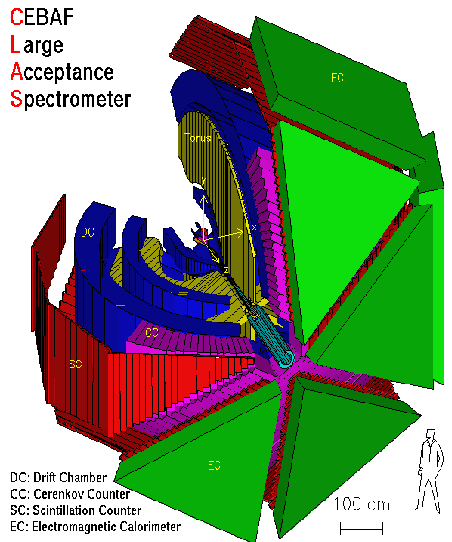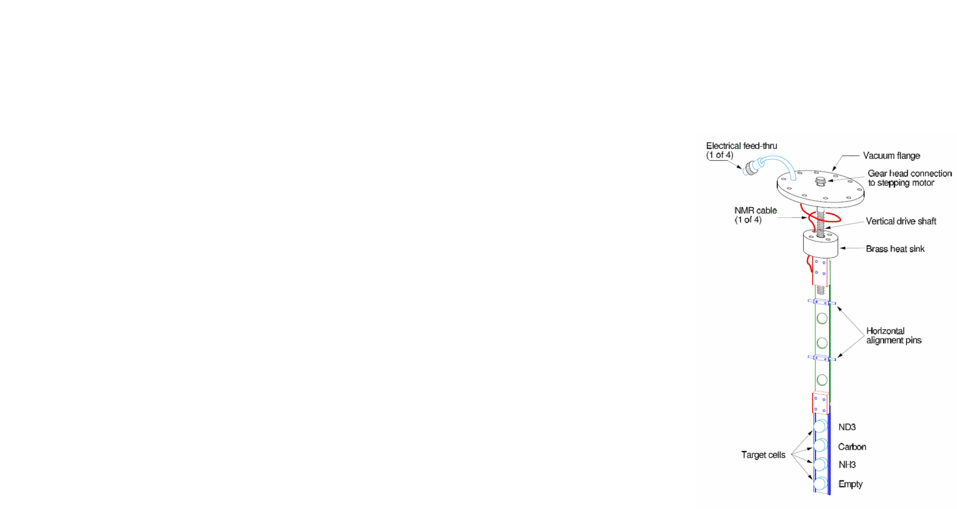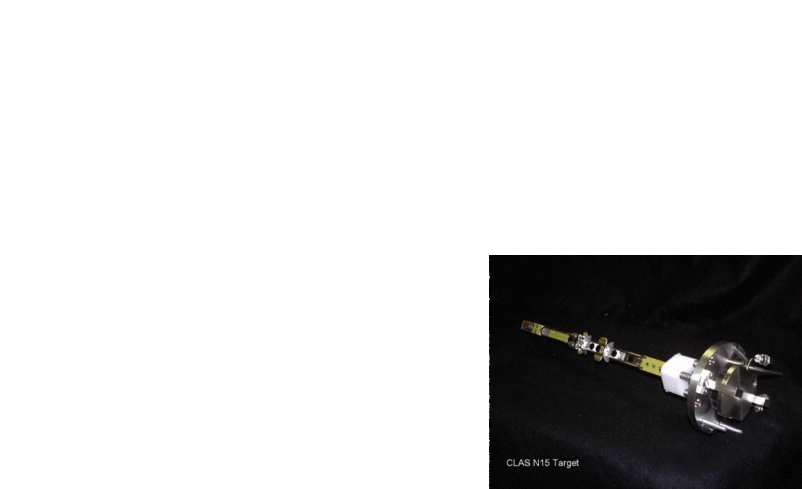CLAS apparatus
Apparatus
Target
In EG1b experiment, the polarized targets and were designed and built by collaboration of the Italian Istituto di Fisica Nucleare, TJNAF, Oxford instruments and the University of Virginia. To study the dilution because of the unpolarized material in the target were used the , and frozen targets. The solid targets(,) were polarized using the method of Dynamic Nuclear Polarization.
The Target System
The Magnet
The 5 T magnetic field parallel to the beam direction is produced by a superconducting pair of Helmholtz coils, which are cooled by the liquid helium reservoir located outside the CLAS detector. The uniformity of the field is varying less than over a cylindrical volume of 20 mm in diameter and length. This configuration is necessary for DNP. The particles with scattering angles between 0-50 are detected in the CLAS as well as 75-105 due to the 8 cm gap between the Helmholtz coils. The target magnetic field does not interact with the electron beam, however it is effective in shielding the drift chambers from the low energy Moller electrons.The target field bents the scattered particles in the azimuthal direction and it falls rapidly with distance as (). The effect of magnetic field at the drift chambers is negligible.
The Evaporation Refrigerator
The target is cooled to ~ 1 K using the helium, which is supplied from the 1 K evaporation refrigerator. Approximately 0.8 W cooling power is provided by a system of Roots and rotary-vane vacuum pumps that reach a pumping speed for helium gas of 3300 [reference !!!!!!!!].
The Target Inserts
The target insert was designed and built by the INFN of Genova. The target cells with a thickness of 0.2 mm were made out of polychlorotrifluoroethylene (PCTFE), it is a hydrogen-free material and would not produce an NMR background, also it is not effected by radiation as much as other materials. Each target cell is 15 mm in diameter and 10 mm in length sealed by a 0.025 mm thick aluminum foil at entrance window and 0.05 mm thick kapton foil at exit window. LHe in the target cells are supplied from the tiny holes which are located at the exit window and the ammonia beads.
The target insert has the four target cells. Two of them were filled with ammonia beads: the top one with and the other one with . was followed by carbon () disk with a thickness of 2.3 mm and the fourth cell was left empty. The carbon and the empty cells were used to measure background.
The Nuclear Magnetic Resonance(NMR) coils were wrapped around the outside surface of the cells in order to reduce the background, maximize the amount of ammonia in the target cells and monitor the polarization of the target. The geometry of the NMR coils were chosen so that they would be maximally sensitive to the target polarization. They were made out of CuNi material with a thickness of 0.15 mm and bent into rectangular loops. The temperature sensors(thermocouples, RuO resistors) were attached to the target insert at different locations to monitor the temperature of the target materials.
A second target insert was designed and built by the Jefferson Lab Polarized Target Group to measure the background using solid . The first measurements of electron scattering from target provided the data which was subtracted from the scattering data in order to eliminate the contribution of the . The insert cell is made out of a Torlon of 15.7 mm in diameter and 12.7 mm in length. Both sides of the cell are covered by kapton windows. The target cell was filled with isotopically enriched gas at room temperature and the insert was located into the target chamber in order to cool it by LHe, causing the gas to condense. To avert the target from freezing a heater wire was wrapped around the filling tubes and plugging the tubes before the cell was filled with the gas.
The target insert during the experiment is moved up or down using the stepping motor, which means that the target can be changed automatically.
The Microwave System
The ammonia beads were irradiated by the microwave field to polarize the target material, without reversing the magnetic filed.
Dynamic Nuclear Polarization
The Nuclear Magnetic Resonance System
During the EG1b experiment the target polarization was monitored by a Nuclear Magnetic Resonance system. The princple of the NMR is to induce and detect nuclear magnetic transitions, where the transition rate is proportional to the population difference between the energy levels, showing the original polarization value. The macroscopic magnetization of the material is related to its polarization in the following way:
where V is a sample volume, N-number of spins, I - the spin value and - the magnetic moment of the individual spins.
Target Material
The target material used using the experiment were frozen ammonia, for the polarized protons and for the polarized deuterons. Ammonia targets were selected because of their ability to produce high polarization and they are less effected by beam radiation. On the other hand, the damage caused by this radiation can be repair by annealing(heating process).
Tracking System
Scintillators
The CEBAF Large Acceptance Spectrometer (CLAS) is equipped with 288 scintillator counters. The purpose of the scintillator is to determine the time of flight for the charged particles and to trigger it in coincidence with another detector system for the particle identification. The time of flight system is built so that time resolution at small polar angles ps and at angles above 90 degrees ps. This time resolution helps to discriminate pions and kaons up to 2 GeV/c.
The time of flight system is located between the Cherenkov detectors and electromagnetic calorimeters. The scintillator strips(BC_408) are located perpendicularly to the average particle trajectory with an angular polar coverage of 1.5 degrees. Each sector of The CLAS detector consists of 48 strips with a thickness of 5.08 cm. The length of the scintillators varies from 30 cm to 450 cm and the width is between 15 cm at small polar angles and 22 cm for the large angles.
Each scintillator of the CLAS detector is surrounded with a photomultiplier tube. When particle hits the scintillator strip, part of its energy can excite atoms in the scintillator which in the end produces light(visible). The produced light is transmitted to the photomultiplier tubes by light guides.
For each photomultiplier tube the time and pulse height are measured. This is important to evaluate the time-walk correction and in addition, the measure of the pulse height gives information on the energy released by the crossing particle.
Cherenkov detector
The CLAS Cherenkov detector is a threshold gas counter filled with perfluorobutane gas at atmospheric pressure. Perfluorobutane was chosen for its high index of refraction n=1.00153, which results in a high photon yield and the following energy thresholds, for electrons 9 MeV and for pions it is 2.5 GeV. The Cherenkov detector is used to distinguish electrons from pions. The six superconducting coils placed at angles of 60 degrees in the azimuthal angle around the electron beam line produce a 5 T magnetic field.It is important to minimize the amount of material in all of the detectors to minimize hadron and electron absorption and secondary particle production upstream of the time-of-flight scintillators and calorimeters. The detector was divided in the six sectors with each sector independently instrumented to be an effective spectrometer. The Cherenkov detector was designed to maximize the coverage in each of the sectors up to an angle degrees.
As a light collector were used the system of mirrors , the light collecting cones and photomultiplier tubes(PMTs). In the extreme regions of the angular acceptance of the spectrometer the number of detected photoelectrons is too low. To get acceptable efficiency of the detector in these regions were placed photomultiplier tubes.
The charged particle trajectories are in planes of almost constant azimuthal angle, because of the toroidal configuration of the magnetic field. Under this conditions, the light collection can be designed to focus the light in the azimuthal angle direction. However, the polar angle is constant. Each of the six sectors was divided into 18 regions of the polar angle and each segment was bisected into two modules by the symmetry plane. This results in a total of 12 identical subsectors around the azimuthal direction for each the polar angle interval and a total of 216 light collection modules.
The optical elements of each module were two focusing mirrors one elliptical and the other one hyperbolic, a "Winston" light collection cone and a cylindrical mirror at the base of the cone to improve the focusing. The light was detected by means of 5 in. Phillips XP4500B PMT placed at the base of the Winston cone.
The photomultiplier tubes were surrounded with high permeability magnetic fields,because they were located in the fringe field region of the spectrometer(??????).
Below is shown the scheme of CLAS detector
Calorimeter
The CLAS detectur contains 8 modules of electromagnetic calorimeter. A calorimeter is a device that measures the total energy deposited by a crossing particle. They are useful in detecting neutral particles and distinguishing between electrons and hadrons due to their different mechanism of depositing energy.The CLAS calorimeter has three main functions:
1) detection of electrons at energies above 0.5 GeV;
2) detection of photons with energies higher than 0.2 GeV;
3) detection of neutrons, with discrimination between photon and neutrons using time-of-flight technique.
6 calorimeter modules of the CLAS detector are placed in each sector in the forward region (polar angle of 10-45 degrees, forward angle calorimeter), while the other two modules are located at large angles in sectors 1 and 2(50-70 degrees, large angle calorimeter). The forward calorimeter has a lead/scintillator thickness ratio 0.2, with 40 cm of scintillators and 8 cm of lead per module. The lead-scintillator sandwich is shaped as a equlaterial triangle in order to match the hexagonal geometry of the CLAS detector. It is made of 39 layers of a 10 mm BC_412 scintillator and lead sheet of thickness of 2.2 mm. Each scintillator layer contains 36 strips parallel to one side of the triangle, with this configuration each orientation is rotated by 120 degrees from another one. This gives three views each containing 13 layers providing stereo information of the location of the energy deposition.
To improve hadron identification, there was provided longitudinal sampling of the shower. Each set of 13 layers were subdivided into an inner 5 layers and outer 8 layers stack.


